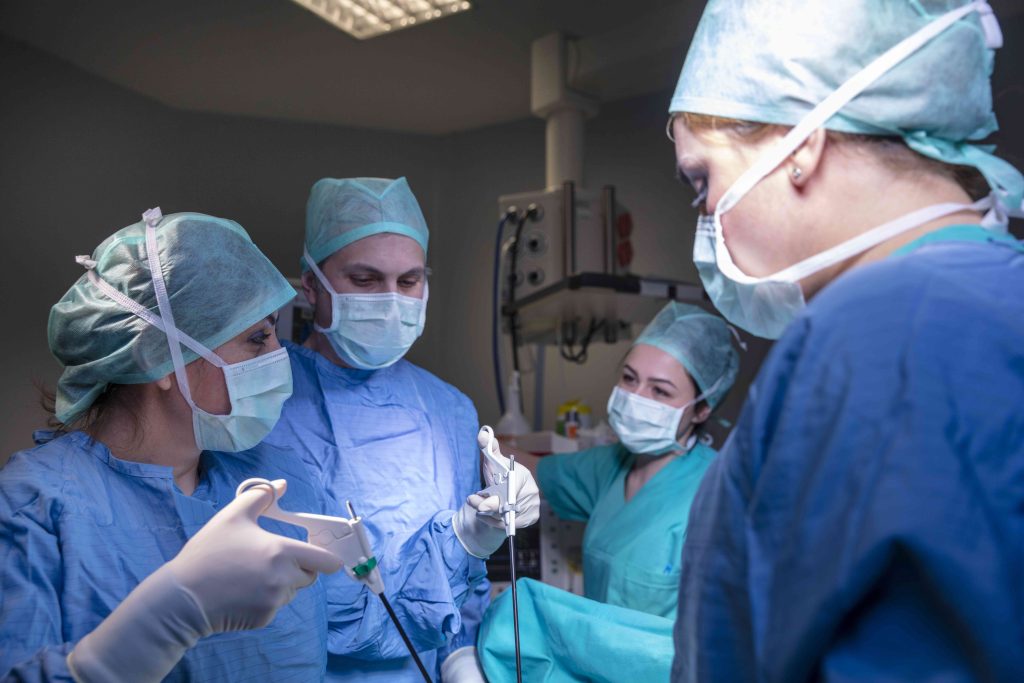:max_bytes(150000):strip_icc():format(jpeg)/Health-GettyImages-1180850640-11b92b6b921a4b43b68b262db505a9b5.jpg)
Laparoscopy is a minimally invasive procedure that allows healthcare providers to examine the inside of your abdomen or pelvic area without making large cuts. The instrument used for the operation is a laparoscope, a thin, lighted tube with a video camera at its end.
Laparoscopy can diagnose and treat endometriosis, which occurs when uterine tissue or cells similar to the lining of the uterus grow outside the uterus, such as in the ovaries and fallopian tubes.
Laparoscopy is useful both for diagnosing and treating endometriosis.
Laparoscopy is the only official method to diagnose endometriosis. If a healthcare provider thinks you may have endometriosis—such as if you have pelvic pain, heavy periods, and fertility issues—they will perform a laparoscopy to look for signs of endometriotic lesions or scarring.
Healthcare providers may also use laparoscopy to treat endometriosis. During the surgery, they can remove or destroy any tissue that may be causing your pain or other endometriosis symptoms. However, providers typically suggest hormone therapy, lifestyle changes, physical therapy, and pain management first.
Healthcare providers may use laparoscopy to either diagnose or treat endometriosis. The procedure is largely the same, but what they do inside may differ depending on the reason for your laparoscopy.
Diagnostic Laparoscopy
This procedure is used to diagnose endometriosis. The healthcare provider makes a small cut in the abdomen, passes the laparoscope through, and examines the contents of the abdomen and pelvis using the attached camera. They may also take a biopsy (tissue sample) and send it to the lab for testing.
Diagnostic laparoscopy can be performed to determine the cause of symptoms, especially when imaging tests, such as transvaginal ultrasound or magnetic resonance imaging (MRI), have unclear results. It also helps providers determine the best treatment.
Laparoscopic Surgery
This procedure is used to treat endometriosis. A healthcare provider makes several small incisions in the abdomen to insert narrow, tubed instruments called trocars. Trocars allow the surgeon to pass the laparoscope and surgical tools like scissors and clamps into the abdomen.
There are two common forms of laparoscopic surgery:
- Laparoscopic excision: The surgeon uses the laparoscope to find endometriosis lesions. They use surgical tools to cut the lesions away from the affected organs. This method targets the entire lesion, including the root. It is particularly ideal for deep-infiltrating endometriosis (DIE).
- Laparoscopic ablation: Once the affected tissue is found, the surgeon destroys it by heating, freezing, or using laser beams. This method is ideal for treating smaller endometriosis lesions that sit on the surface of the affected organ.
Laparoscopy for endometriosis is often done in a hospital or outpatient surgery center. Your healthcare provider will discuss your procedure, including how to prepare and what to expect during and after it.
Here are some things to keep in mind:
- You will need to provide written consent for the procedure beforehand
- You will need to fast (not eat or drink) before the procedure; your provider will instruct you on how long
- Consider wearing loose-fitting clothes; you may feel sore and experience a bloated abdomen after the procedure
- You may need to stop medications such as opioid pain relievers for a while before the laparoscopy; tell your healthcare provider about any drugs or supplements you take
- If you are staying overnight, pack a small overnight bag
- Bring your insurance information, any out-of-pocket payment, and an ID card
- Make plans for who will take you home after the procedure
Regardless of whether you are having a laparoscopy to diagnose or treat endometriosis, the surgeon will make small incisions in your abdomen so they can gain access to your pelvis.
If the surgery is for diagnosis, they will use the video camera on the laparoscope to look for signs of endometriosis. They may take a biopsy for testing.
If the surgery is for treatment, they will use the video camera to guide them as they remove or destroy the affected tissue.
During the Procedure
Here is what to typically expect during the procedure:
- You will put on a loose-fitting gown and lie on the operating table.
- You will be given general anesthesia so that you are sleeping during the surgery. It may be administered through your vein or a breathing mask.
- Your provider will expose the area of the skin where incisions will occur and clean it with a disinfectant.
- The surgeon will make a small cut near your belly button.
- Through that cut, they will insert carbon dioxide into your abdomen. This inflates your belly with gas, giving them a better view inside.
- They will insert the laparoscope, moving it around to see different angles of the abdomen.
- If you are getting a biopsy or having tissue removed or destroyed, the surgeon may need to make additional cuts in your abdomen so they can insert more tools.
- When they are done, the surgeon will remove the tools and most of the gas. They will close up the incisions and cover them with bandages.
After the Procedure
After the laparoscopy, your healthcare team moves you to a recovery room, where they will closely monitor you until the anesthesia wears off.
It is normal to feel pain or soreness around the incision site at this point. Your healthcare provider will likely prescribe a pain relief medication. While they may want you to stay a few hours after the procedure to recover, you probably won’t need to stay overnight.
Your healthcare provider will provide you with more information about what to expect in the days following the laparoscopy and when to return for a follow-up appointment.
Laparoscopy for endometriosis is generally safe, hardly causing serious problems. Like any procedure, there are still some risks. Some people may experience:
- Bleeding
- Infection
- Damage to a blood vessel or organ
- Blood clots
- Complications linked to anesthesia
You can lower the risk of complications by telling your healthcare provider about allergies, such as anesthesia, beforehand and sticking to your post-surgery care instructions.
Your healthcare provider will let you know when to expect your laparoscopy results. Depending on the facility, this may take a few days or a couple of weeks. They will also tell you how to access the results—via email, phone call, online portal, or a visit to the clinic.
Interpreting Your Results
Your healthcare provider will interpret the results of your laparoscopy. In the case of diagnostic laparoscopy, if the test shows endometriosis tissue growing outside the uterus, your healthcare team will discuss the next course of action with you, including treatment options.
In the case of laparoscopic surgery, they will tell you how successful tissue removal or destruction was.
Laparoscopy involves making a small incision in the abdomen and inserting a laparoscope to examine the body.
Laparoscopy is the only way to make an official endometriosis diagnosis. Healthcare providers may also use laparoscopy to remove tissue causing your endometriosis symptoms.
Laparoscopy is minimally invasive and has little risk. To reduce any risk, follow your healthcare provider’s instructions on preparing for the procedure and what to do afterward.








